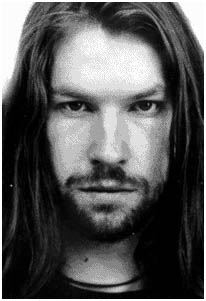
Salone Magazine Interview
 Remember logic bubbles, your first introduction to the concept of logical sets back in sixth grade? Here's a timely example: Not all sound is music, but all music is sound. Hence, music is a small bubble inside the larger realm of sound in general. Given such a model, there's a clear and present trend to camp right on the line between the two. Last year's monster single "Setting Son" by the Chemical Brothers became the bull's-eye that everyone from Depeche Mode ("Barrel of a Gun") to U2 ("Discotheque") has been aiming for, trying to marry industrial noise with a genuine rock 'n' roll backbeat, and consummate the union with a half-dozen synthesizers.
Remember logic bubbles, your first introduction to the concept of logical sets back in sixth grade? Here's a timely example: Not all sound is music, but all music is sound. Hence, music is a small bubble inside the larger realm of sound in general. Given such a model, there's a clear and present trend to camp right on the line between the two. Last year's monster single "Setting Son" by the Chemical Brothers became the bull's-eye that everyone from Depeche Mode ("Barrel of a Gun") to U2 ("Discotheque") has been aiming for, trying to marry industrial noise with a genuine rock 'n' roll backbeat, and consummate the union with a half-dozen synthesizers.The man with the wand behind all this hybrid bubble-blowing is Richard James. As Aphex Twin, AFX, Polygon Window and a handful of other projects, James has been redefining the horizon between music and sound. The English artist doesn't so much make music as build it from scratch with found sounds, homemade electronic instruments and a bank of PowerMacs.
Casual fans may not realize how far James has come down the road of compromise to meet them: He's a notorious curmudgeon who may be more comfortable in the obscure bins of experimental, ambient, trance and techno, but "Richard D. James" is a clear acknowledgement of commercial considerations. Unlike previous albums, the tunes here have titles, and James even sings on two tracks, including the dangerously catchy piece "Milkman" — though it's watermarked with a naughty lyric to insure limited airplay. On the other hand, "Fingerbib" and "Goongumpas" are unapologetic quotes of na´ve environmental music in the tradition of Muzak, while "4" and "Peek" are pure, synthetic romps in sonic minimalism. "Cornish Acid" and "Carn Marth" fill out the picture, indicating why James has been a favorite on the dance floor, with [their] deep disco scapes sure to be coming to a rave near you in '97.
The balance of "Richard D. James" may be viewed as a setting for "Girl/Boy Song," a complex piece that's presented in three separate mixes. Here, James has created the sonic equivalent of a time-lapse movie: You can hear the smooth melodic arc of the sun climbing and then falling over a very busy, contrapuntal city scene. It's an evocative weave — skillful sound engineering and emotive musicianship built from the ground up.
"Richard D. James" may be the best record you won't hear this year. In the tradition of Kraftwerk, Tangerine Dream and Wendy Carlos, it'll be remembered as one of the ur-texts of the new electronica. Though it's not likely to register on SoundScan or Billboard, Aphex Twin's influence will be felt for many years to come, reminding anyone who's interested why it's so important to have liminal artists and records that survive and thrive in spite of the music industry's mass-market sympathies.
Yeah, but is it sound or is it music? Well ... far be it from me to burst your logic bubbles.
Written by: Hans Eisenbeis, 1997, Salone Magazine